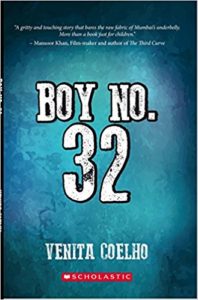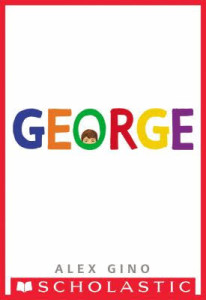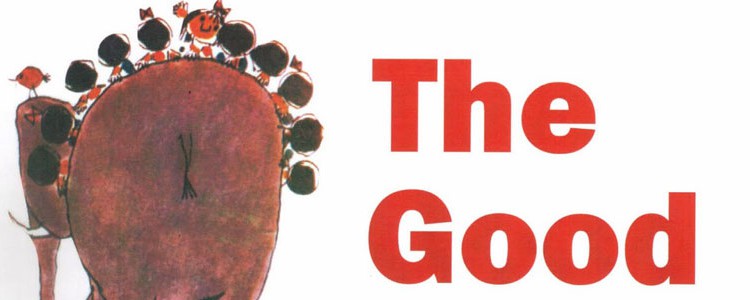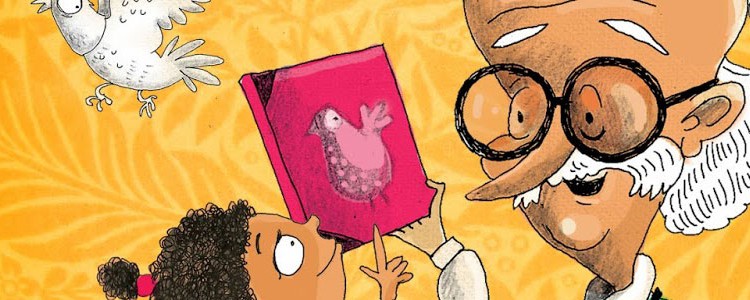An interview with Venita Coelho, “Boy No. 32”
 Venita Coelho works with images, words and paint. She is a writer who has worked in film, television and literature. Her published work includes Dead as a Dodo which won the Hindu Award for the Best Fiction for Children 2016. The Washer of the Dead was long listed for the Frank O’Connor award. She is a screenwriter with films for Dharma Productions and Sanjay Leela Bhansali Productions to her credit. As an artist she works with charcoal and with acrylic paint on glass. She is about to set off on a great adventure – having converted a Tempo traveller into a caravan, she and her daughter are off to travel across India.
Venita Coelho works with images, words and paint. She is a writer who has worked in film, television and literature. Her published work includes Dead as a Dodo which won the Hindu Award for the Best Fiction for Children 2016. The Washer of the Dead was long listed for the Frank O’Connor award. She is a screenwriter with films for Dharma Productions and Sanjay Leela Bhansali Productions to her credit. As an artist she works with charcoal and with acrylic paint on glass. She is about to set off on a great adventure – having converted a Tempo traveller into a caravan, she and her daughter are off to travel across India.
Venita Coelho’s recent young adult novel Boy No. 32 is an incredibly gripping book about Battees, an orphan named so after the number given to him — 32. ( In Hindi, the number 32 is called “battees”.) The story is about Battees winessing the presence of a dreaded terrorist, Kashmiri Lall, in his city, Mumbai, and he is now the only one who can help put him behind bars. It is a tremendously well-paced and tautly written book. Impossible to put down once you begin it. Also for the fact Venita Coelho never for an instant “talks down” to youngsters, nor is ever apologetic about the violence around us. Absolutely fantastic!
In this novel intermixing the orphans’ quest for locating Kashmiri Lall with encounters with the eunuchs, the Beggar King, and the horrific complicity of even the adults responsible for them such as Aunty and the cop, is done crisply. The “traditional” bad guys of literature like the eunuch are actually shown to be humane with a little more insight on how their community operates. Equally well-made are the cop and the “aunty” who are so incredibly corrupt, they would do anything for a few extra bucks. Venita Coelho is constantly challenging pre-conceived notions about characters. For instance, instead of giving the warden of the orphanage a name, she is referred to as “Aunty” — a big learning curve for Indian readers who are taught to practically revere an older woman, inevitably calling her “Aunty”, sort of seals this relationship.
Boy No. 32 is highly recommended!
Here are excerpts from an email interview:
I could not help wonder how you came upon this idea? Why?
It came out of the years I spent in Mumbai. The many times I caught the last train out of Churchgate and chatted with all the urchins in the compartment. It came out of all the stories they gave me and the adventures that the city gave.
How long did it take to write? How many revisions did it require?
I am a three draft writer. Knocked the first draft out across one November ” Nanowrimo”. That is ‘National Novel Writing Month’. You sign up at the website and for one month you get cheerleaders who push you along as you frantically write. People around the world are racing to finish their novels and the collect energy is quite astounding. The next two drafts took about eight months. But that was along side being a single mum, earning my living, and surviving Hindi films.
I can see it easily adapted for a school theatre performance — was that your intention?
It’s a movie! We don’t make children’s films in India. Every Hindi film with its songs and dances is essentially a children’s film. There is never a budget to make a ‘children’s film’. So I just put it in a book – Item number and all.
How did these characters come about? Which one struck you first?
Definitely Battees. He’s based on all the cocky little boys who sat down next to me at stations and launched into long stories. I so deeply admire the sheer courage and unputdownability these kids display, and I really wanted one of them to tell his story in his voice. And I have a very big soft spot for Item. Such courage. Such a diva!
Has your day job of writing scripts for the Indian film industry help craft young adult novels?
Not really. Hindi films have no idea of how to talk to young adults. All they ever offer them are mushy love stories. In fact to switch from writing films to books I normally have to do a couple of weeks ‘detox’ when I consciously switch from writing scenes and move to writing descriptions. Another level is moving from the superficial level of films to a deeper emotional level for books.
What has been the response of the kids who have read the book? Have you encountered them at your sessions in different cities?
We’ve had riotous sessions. The kids always love the elephant story – and it gets them thinking about real patriotism. And I always tell them that only one thing separates them from the kid on the street – sheer luck. They could have been born anywhere. And it is their duty to pass that luck on. It always makes for lively discussions.
Do you get different responses to your stories from boys and girls or does a gendered reading not matter?
I haven’t found that gender makes much difference to the response. Girls tend to ask more questions though.
Do you write with a specific reader/audience in mind?
Nope. Never do that. You can never tell how a story is going to turn out. An adult story might find it’s own way to be a children’s story. A writer can’t really predict how pitch and tone will finally tune itself. I let the story find it’s own audience. I try to write interestingly enough for anyone at all to be able to read the story.
Before publishing, do you “test” the story out or go with your instinct. I ask since I found the novel pitch perfect.
I did have three readers for the final round. It was a first for me. I got some good feedback and I will try it. again. But basically I have had so much damn writing practice doing television that it’s finally coming easy. When you do a daily soap you write 5 episodes a week. That’s ten hours of TV a month. That’s a heck of a lot of writing!
What is next on the cards?
I’m working on three different books. I tend to bounce between books. The one closest to my heart is a story based on my growing up in Kolkata. I grew up in a building that the Indian government had acquired to house the jews that it rehabilitated after the holocaust. I grew up hearing stories of the concentration camps. Now I’m finally ready to write them down.
Would you ever consider writing a series arc for young adults?
Of course. Just finished the first book of what is meant to be three books in total. I love the space that ‘Fault in our Stars’ occupies. Now that is really young adult space. So I have done a book that is for really young people, with a love story at the heart of it – but also the issues of terrorism, violence and ahimsa. Let’s see how it does!
Venita Coelho Boy No. 32 Scholastic India, Gurgaon, India, 2017. Pb. pp.186 Rs. 295









